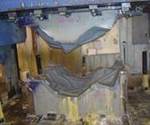Solvent-free release a good match for wind blade molding
Wind power’s reputation as a “green” technology belies the fact that production of turbine components requires many materials and products that aren’t green.
Wind power’s reputation as a “green” technology belies the fact that production of turbine components requires many materials and products that aren’t green. Because partial release of parts 60m/195-ft long or longer can damage blade shells and slow down the production process, many consider solvent-based, semipermanent releases the right choice because they allow multiple parts to be pulled after a single application and don’t transfer to the parts. They do, however, emit large amounts of volatile organic compounds (VOCs) when applied to such large surfaces, degrading air quality. Because tighter environmental rules in the U.S. and the EU’s Volatile Organic Compounds (VOC) Directive are limiting the use of solvent-containing products, blademakers are seeking alternatives that are more consistent with the image of renewable energy.
Henkel Corp. (Rocky Hill, Conn. and Düsseldorf, Germany) recently developed and trademarked Frekote Aqualine C-600, a water-based mold release targeted to wind blades. Developed as part of a joint U.S./European research project involving several Henkel business units, the product is now in use at several major North American wind blade manufacturing facilities, and is available in Europe, says Jay Reddy, Henkel’s Frekote market and product manager.
When the release is sprayed onto the mold, the water in the formulation evaporates at room temperature, leaving behind the active chemicals in a layer just 0.005-mm/0.0002-inch thick, explains Reddy. Aqualine C-600 is nevertheless robust enough to allow multiple pulls, extending the interval between mold cleaning and release application and saving considerable labor cost. Because shop air does not have to be treated, blade manufacturers also can save operational costs. According to Reddy, the product performs as well as semipermanent mold release, based on head-to-head testing at customer facilities.
Related Content
-
Mold 3D printing helps automate composite bathtub, shower production
As part of its efforts to automate as much of its production process as it can, Lyons Industries acquired a Massivit 10000 additive manufacturing system to quickly produce high-performance molds and support fixtures.
-
TPI, UMaine, ORNL to leverage world’s largest polymer 3D printer for wind turbine tooling
Ingersoll Masterprint LFAM printer will be used to produce and demonstrate 100% recyclable tooling that could cut large composite blade development cycles and tooling costs by as much as 50%.
-
Corebon induction heating
This sidebar to CW’s August 2024 feature article reviews this technology for more efficient composites manufacturing and why it aligns with Koridion active core molding.



